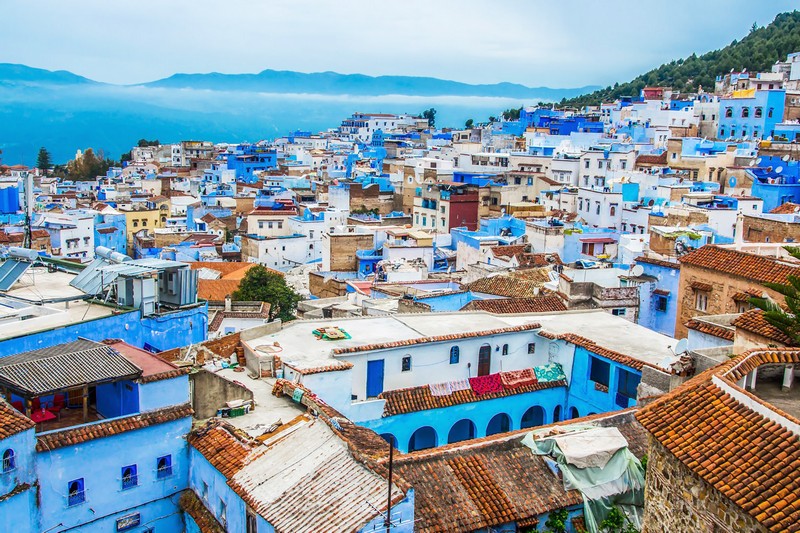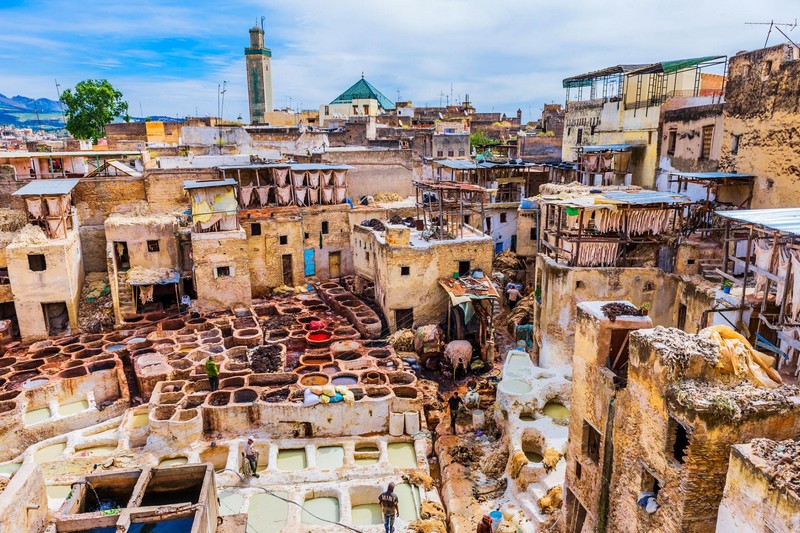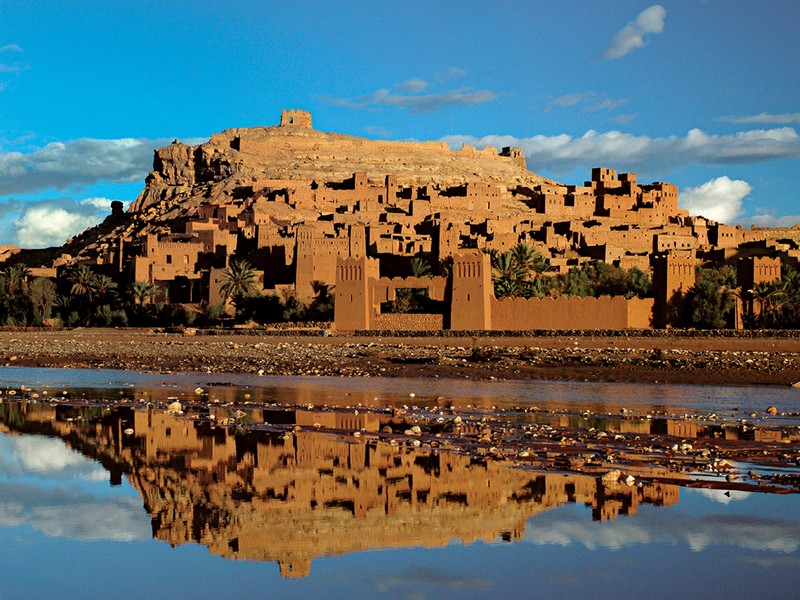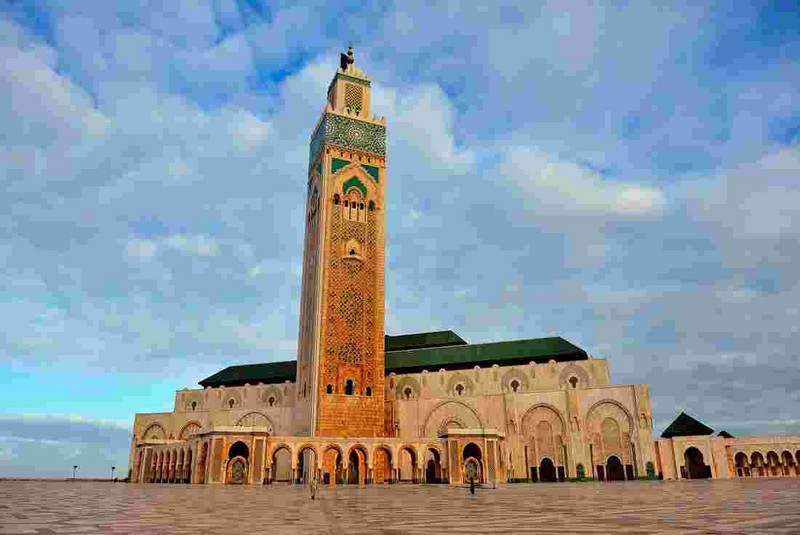(#wanderlusttips #Morocco) I often visit a market when I wander through a new city or country. Markets are the colourful prisms that help me understand the local culture of the places I visit. They reflect the true daily lives of the locals, and if I stumble upon an ancient market, I can imagine the mysterious and unique history that shaped the place.
[rpi]
Morocco has many ancient open markets. Most commonly these are walled market complexes known as a medina. In Morocco, each city has numerous medinas, dating back hundreds or even thousands of years. A medina is the place where locals live and work. Small markets selling local produce and unique craft villages make up such a market complex, which is divided into areas offering different products like woodcarvings, leather, votive offerings, bronze goods or spices. During ten days travelling in this North African country, I was fascinated and tried to visit all the famous medinas. Each of them adding a stroke to the painting that is the culture of Morocco: the medinas in Tangier which sell many goods from the country and abroad to European visitors; the mysterious medinas in Chefchaouen urge visitors to live slow and experience every moment of life; the thousand-year-old medinas with traditional craft villages in Fes; a medina in Marrakech which can make any visitor forget their way home; or the ancient feel of the medinas in Meknes.
The world of the past is just a few steps away
Once you’re in Morocco, it would be a waste not to visit Fes, the third largest city in Morocco. This city is home to one of the oldest medinas in the world, formed in the 9th century. At dawn, before the shops open, I hurriedly walked around this maze, which resembles a giant cobweb. A glimpse of the past seemed to open before my eyes, shop after shop. The men scramble to unload their cargo from donkeys to prepare for a busy day of trade. Medinas in Fes are famous for their traditional crafts, especially leather tanning which has maintained its traditional way of being produced for thousands of years. I saw a sign leading to the leather tanneries, which appear on many Moroccan postcards. The medinas in Fes are home to some of the oldest leather tanneries in the world, formed in the 9th century. My first impression was the smell of leather, not the sight. Leather tanneries all have a stairway leading to the rooftop, so visitors can enjoy the view of the outdoor workshops. There are many leather shops in the area around the leather tanneries, and their rooftops and terraces are accesible for tourists to enjoy the view and take photos. This craft dates back to the 11th century, when exported leather goods produced in Fes first became famous. From up high, you can see hundreds of colourful round pits below. Half of them are blue and white, and the other half is other colours. The red colour is produced from the henna plant, yellow made with saffron, and green from mint leaves. After cleaning and dyeing the leather, it is dried on the roofs of the medinas or on the hillsides around Fes. This process has been taking place for about 500 years, and the locals do not want to modernise their techniques, so as to maintain their unique traditional craft.

Men, young and old alike, jump into the pit without any protective gear and immerse their body in the water to clean or dye the leather. They have been doing this work for generations, and maintain the craft inside the medina as a testament to the vitality of history.
Get lost in Marrakesh
Moroccan people often tell travellers: “Try to get lost in Marrakesh”. I followed this advice, and floated through the culinary world of Marrakech.
The centre of Marrakesh is the medina, surrounded by a long wall made of red sandstone. Thanks to this distinct red colour, Marrakesh is also nicknamed “Red City”. The medina in Marrakesh is not as big as in Fes, but filled with winding alleyways. The medina is like a mysterious world; the further you walk, the harder it is to find your way back out.
The centre of the medina is Jemaa el-Fnaa Square. During the day, this place attracts many tourists and Moroccans in their traditional dresses invite them to take pictures, old snake whisperers, street carts filled with fruit or souvenirs for tourists and locals alike. At nighttime, the atmosphere at the square is even livelier, as this place turns into a bustling night market; a must-visit for any visitor to Morocco. The market stays open very late, offering a lot of delicious local street food. You can find all local dishes in this culinary paradise of Marrakesh.

Tajine is the dish available at any restaurant in Marrakesh, from the luxurious ones with belly dancing performances, to the cheap eateries hidden in small alleyways. This is a traditional stew cooked on a small coal fire. Tajine is named after the unique type of container this dish is served in: a deep earthen plate with a conical lid. The tajine is produced in various sizes and different decorations and colours. Thanks to the special shape of the container, the food is always well cooked, soaked in delicious spices without being crushed. During my two days in Marrakesh, I took the opportunity to try different types of tajines: beef, chicken, lamb, fish and vegetables. Tajines can have different flavours thanks to the different recipes incorporating a variety spices and herbs such as coriander, pepper, chilli, turmeric, olive, onion, and roasted and crushed star anise. I was the most impressed with the lamb tajine, which I ate at the night market in Marrakesh. The lamb had been rid of the usual odour, and was cooked with potatoes, olives, tomatoes, and spicy green pepper. The more I ate, the more I realised the richness and diversity of Moroccan cuisine, not only because of the ingredients but also thanks to the hundreds types of spices used in the kitchens of this North African country.
Slow living with an aromatic cup of green tea in Chefchaouen
Relax after exhausting days moving around Morocco by spending the rest of your time living slowly in Chefchaouen.
I did not rush to get around like in Fes or Marrakesh. I spent an entire morning admiring the old town, covered in the illustrious colour of the sky. From the rooftop of my hostel, I realised that Chefchaouen quietly nestled in the foothills of the Rif Mountains was waiting for tourists to visit and find some leisure in life.

The hostel owner kindly offered me a hot pot of tea. It was the traditional Touareg tea of the Moroccans, a combination of green tea, fresh mint leaves and sugar. People in Chefchaouen often welcome their guests with three kinds of tea, all of which have different flavours and meaning. The first is the gentle flavour of life, the second is the passionate flavour of love, and the third is the bitter taste of death. If you refuse to drink one of these three kinds of tea, you will be perceived as impolite. For the locals, tea is their favourite drink, as Muslim men are not permitted to drink alcohol.
The sunset in Chefchaouen seemed to urge me to stay longer in this neighbourhood. In Morocco, you can find a medina everywhere, but Chefchaouen is the place that everyone wishes to revisit one day.
TIPS:
Must-knows when visiting Morocco:
Time: The best time to visit Morocco is from June to September. Despite the humidity during these months, the weather is quite warm with little rain, and the highest temperature is about 20 degrees Celsius. Blue skies and snowy mountain peaks are the perfect backdrop for photography enthusiasts.
Visa: You can apply for a visa at the Moroccan embassy at No. 9, Chu Van An Street, Ba Dinh District, Hanoi. The embassy will issue a single entry visa according to the duration of your visit. The visa fee is 50 USD per person.
Transportation: From Vietnam, you can reach Morocco by flying with Turkish Airlines, Qatar Airways or Emirates Airways. Airfare is about 800 – 1,000 USD for round trip tickets. Flights often transfer in Istanbul, Doha or Abu Dhabi before reaching Casablanca, the largest city in Morocco. From here, you can catch a bus or train to reach Fes, Marrakesh or Tangier. You can book high quality bus tickets at http://www.ctm.ma/ to get to the different cities in Morocco, or visit the train stations in big cities.
Accommodation: In Morocco, you should not miss the famous medinas. Staying at traditional Moroccan houses (Riad) inside the medinas allow you to conveniently explore the old town. Riads are ancient, cosy, uniquely decorated and often have rooftops for tourists to enjoy a beautiful sunrise or sunset. Riads offer double rooms or dormitory beds, suitable for backpackers. You can check out some Riads such as Casa Ellias (Chefchaouen), Riad Sunrise (Fes) or Riad Zanzibar (Marrakech) with an average price of 25 – 30 USD/person/double room.
Cuisine: Through the course of history, Moroccan cuisine has been influenced by different cultures. It is a unique fusion of food from Mediterranean, Berber and Andalucía peoples. Moroccan cuisine is the elegant combination of different kinds of meat, fish, vegetables and rare spices, creating delicious flavours. Vietnamese will love the tajines, grilled meat, couscous, boiled lamb and the aromatic mint tea.
Language: Do not be surprised if you hear many different languages in Morocco. In addition to their official language which is Arabic, people here also speak French, Spanish, and local languages such as Tashelhit, Tamazight andTarifit. English is not as popular as French, but it is also used in Morocco, especially in touristic towns.
Religion: Morocco is a Muslim country, so there are a few things tourists must know. You should not use your left hand to do anything in public, because the locals consider the left hand unclean. Moroccans and especially the women do not like to be photographed, so you must get their permission before taking photos. Female tourists are advised to dress conservatively. Most Muslim mosques in Morocco do not let foreign visitors in, the exception being Hassan II Mosque located in Casablanca.
Places to visit in Morocco: Casablanca, Fes, Meknes, Tangier, Marrakesh, Chefchaouen, the Sahara desert and the Atlas mountains. You can buy a tour from Fes to Marrakesh for two days and one night to experience this beautiful path. You will get to ride a camel, spend the night in the Sahara desert, visit the Atlas mountains, the famous Todra Gorges canyon known for adventure sports including mountain climbing or trekking, or visit the world heritage village of Kasbah Benhaddou. The price of the tour is about 150 – 200 EUR per person (about 3.7 – 5 million VND), depending on your choice of hotel. The price excludes lunch, tips and drinks. You can learn more about Morocco Desert Tour by calling +212.667.291.025.
Footsteps | Wanderlust Tips | Cinet

